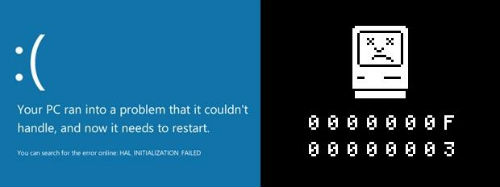 Hidey ho there, computer adventurers! If you’ve been using personal computers for a while, you have probably laid eyes on a Macintosh or two. You may even own one. If you were an early adopter of the Mac, or have used pushed a Mac just a little too far past its breaking point, you have probably seen the “Sad Mac” icon pictured above right.
Hidey ho there, computer adventurers! If you’ve been using personal computers for a while, you have probably laid eyes on a Macintosh or two. You may even own one. If you were an early adopter of the Mac, or have used pushed a Mac just a little too far past its breaking point, you have probably seen the “Sad Mac” icon pictured above right.
On the other hand, if you’ve only used Windows PC’s, then you don’t know what a Sad Mac is. As you can guess, it means “time to reboot” or “you need a new hard drive” or “just exactly what kind of super-computer do you think you’ve got in front of you, pal?” Windows users, especially those who were around for Windows 95 and Windows 98, are very familiar with the “Blue Screen of Death.”
The “Blue Screen of Death” (or BSoD) would appear if you asked Windows to do too many things at the same time, or if that $5 memory stick you got at Wee Willie’s Ram Shack gave up the ghost, or, you guessed it, pushed that Windows PC just a little too far past its breaking point.
The BSoD usually included cryptic error codes in hexadecimal, and odd, mystic phrases that were only slightly related to English. The appearance of the BSoD was greatly reduced after the introduction of Windows XP, even further with Windows Vista, and now the average Windows PC user rarely sees it on a PC loaded with Windows 7. Unfortunately, the BSoD has not gone away entirely.
To make dealing with a hard crash easier, it looks like Microsoft has stolen a page from Apple, and they have “softened” the BSoD as it appears in Windows 8. It now includes a “frowny” emoticon and some simple English language, along with a very short description of the error that caused the operating system to crash. Could this be a sign of a newer, friendlier version of Windows?